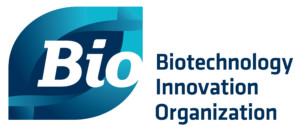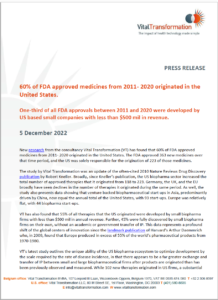The US Ecosystem for Medicines. How new drug innovations get to patients.
Summary and Conclusions
- In November 2010, Robert Kneller published a landmark study outlining the importance of biotech to the US and global innovation ecosystem. Kneller’s data indicated that drugs initially discovered in biotechnology companies or universities accounted for approximately half of the scientifically innovative drugs approved.
- Analyzing a cohort of therapies approved by the FDA from 2011-2020, VT’s research demonstrates the ecosystem evolution of internal/external IP innovation and the role of NIH and government in novel IP creation since Kneller’s 2010 landmark study.
- The geographic location and institution responsible for a drug’s ‘origination’ was identified and compared across geographic locations; distribution of originator type and designations of priority or standard review were compared; the relative impact of originator type and location for sales were determined
- The pathway of IP ownership was identified and tracked at origination, FDA filing, and post-FDA approval. The originator of the IP was classified by their geographic location and sector (i.e., Small, Biopharma <$500mil revenue, Large Pharma >$500mil Revenue, Government, Academia)
- The FDA orange and purple books were used to identify origin of the foundational IP of 363 FDA approved non generic medicines. Patent records for Biologics required a manual search with the U.S. Patent and Trademark Office (USPTO); NIH funded CRADA’s and Intermural grants for patents directly created under government contract were also manually investigated.
- The dominance of American biopharma in global innovation has increased since Kneller’s publication; the USA is responsible for 95% of the increase of 111 total FDA approvals since 2010.
- Industry funded research (small and large companies) originated the IP of roughly 90% of all new medicines globally.
- 1/3rd of Large Industry’s originated U.S. IP is out-licensed to smaller firms, this is unique to the global ecosystem, and shows the ability of firms to adapt to the scale required to develop new medicines by indication.
- The NIH’s CRADA and Intermural grants were directly responsible for the creation of 4 of the 363 new drugs in our cohort; US academic institutions and government created 10% of all indigenously originated U.S. IP.
- 55% of U.S. originated therapies are created by small biotech companies, large companies are responsible for 45%.
- The majority of biologics undergo priority review and target orphan indications at the time of FDA approval.
- The NIH’s role in drug discovery, while vital, is not directly responsible for the development of new therapies.
Methodology
-
Used FDA orange and purple books to identify origin of the foundational IP of 363 FDA approved non-generic new medicines between 2011 and 2020.
-
Patent records for Biologics required a manual search (information absent in purple book):
-
Searched the U.S. Patent and Trademark Office (USPTO) for patent extension claims related to a specific BLA, as recorded in the federal register.
-
Federal USPTO rulings (“Determination of Regulatory Review Period for Purposes of Patent Extension”) were then cross referenced and validated using a drug’s application number, approved use, and FDA approval date from CDER data to the federal register.
-
-
An investigation was conducted to identify NIH funded CRADAs and Intermural grants for patents directly created under government contract.
-
The pathway of IP ownership was identified and tracked at three core points; origination, FDA filing, and post-FDA approval (i.e., current owner).
-
The originator of the IP was classified by their geographic location and sector (i.e., Small Biopharma <$500mil revenue, Large Pharma >$500mil Revenue, Government, Academia).
Supported by:









